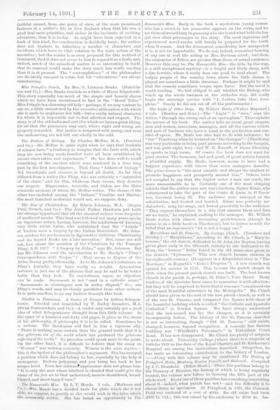Marylebone and St. Pancras. By George Clinch. (Truelove and Shirley.)—"
Marylebone," according to Mr. Clinch, is " Mary-le- bourne," the old church, dedicated to St. John the Baptist, having given place early in the fifteenth century to one dedicated to St. Mary, the " bourne" being found in the old name once given to the district, " Tybourne." This new church became ruinous in the eighteenth century. (It appears in a dilapidated state in " The Marriage," in Hogarth's " Rake's Progress.") A new church was opened for service in 1742. This became the parish chapel in 1818, whoa the present parish church was built. The best.known church in the parish is, perhaps, St. Peter's, Vero Street. Many readers of the Spectator have cause to remember it with affection ; but they will be surprised to learn that it was once " considered one of the most beautiful structures in the Metropolis." Mr. Clinch should have given us the cost of the new parish church, as well as of the new St. Pancras, and -compared the figures with those of the beautiful building which is called " the Catholic and Apostolic Cathedral " in Gordon Square. Wo have always understood that the last-named was far the cheaper, as it is certainly incomparably better. The history of the St. Pancras churches is not so interesting, though " Old St. Pancras " still exists, changed, however, beyond recognition. A scarcely loss famous building was " Whitileld'e Tabernacle" in Tottenham Court Road. Rims now disappeared. Mr. Clinch has plenty of subjects to write about. University College (where there is a misprint of 1869 for 1829 in the date of the Royal Charter) and St. Katharine's Hospital are among the institutions described. Altogether, he has made 'an interesting contribution to the history of. London. —Along with this volume may be mentioned The History of Fringford, Het he, 3faa,bury, , Newton Purcell, and Shelswell. Compiled by 3. C. Blomfield. (Elliot Stock.)—These five parishes belong to the Deanery of Bicester, the history of which is being regularly treated, the volume now before us forming the fifth part of the whole work. Every one of these parishes has something interesting about it—:indeed, what parish has not P—and the difficulty is to choose items as specimens, At Fringford, in 1761, the Common Field was enclosed at a cost of £830. Its old value had been £202 7s. 111 ; this was raised by the enclosure to .2558 8s. Im- mediately afterwhrds the chief proprietor sold his land. The facts about the increased value of land and benefices are very curious. In 1202, Fringford Rectory was valued at £6, in 1341 at £1216s,, in 1685 at £101 13s. 4d. It is now £135, but with 200 acres of glebe (of which no mention is made in the usual returns). Continuous records give the value of an estate belonging to St. Bartholo- mew's Hospital from 1551 down to the present time. In 1551 the rent was 10s., the land being let on lives with a fine for renewal. In 1579, one Henry Spranson, the tenant, offers a fine of 40s. to have his life and his son's put into the lease. The offer seems to have been refused. In 1583, his wife, in right of whom he had held it, dies. The land is valued. Spranson apparently declines the Hospital's terms, and it is let to Richard Rivers for 40s., without fine. In 1602, Oliver Pangbourno gots it for the same rent, with £10 fine ; in 1631, John Beaumond, with £30 for fine. In 1648, the rent is increased to £4, and the fine diminished to £20. (The estate, it should be said, consisted of fifty-nine acres, and the lease was for twenty-one years). In 1688, the fine is sae0 ; in 1732, it it is £105 ; in 1754, .2160. The system of fines was discontinued in the course of time. The highest point reached by rent was in 1872, when it was £110. It is now 475. Even now the increased value is much more than the difference in the fall in the value of money.



































 Previous page
Previous page